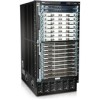Dell PowerConnect J-8216 Hardware Guide - Page 105
Table 42: Power Reserved for the Chassis, 2400 W + 16 450 W
 |
View all Dell PowerConnect J-8216 manuals
Add to My Manuals
Save this manual to your list of manuals |
Page 105 highlights
Chapter 7: Planning Power Requirements To calculate the number of power supplies required for your switch configuration: 1. Determine the power requirement of the chassis-with the fan trays, RE modules, and SF modules, but no line cards-by consulting Table 42 on page 89. The watt values shown in Table 42 on page 89 are the amount of power reserved by power management for the chassis in its power budget. It uses these values when calculating used and available power and when determining whether sufficient power exists to meet N, N+1, or N+N requirements. When power management is configured for N+N power redundancy, it reserves less power for the chassis so that more power is available for line cards. Table 42: Power Reserved for the Chassis Power Reserved for the Chassis N+1 Configuration 2400 W N+N Configuration 1800 W NOTE: The amount of power that power management reserves for the chassis is a set value that does not vary depending on chassis components installed. A J-EX8216 switch maintains chassis power when only one 2000 W power supply is online even though 2000 W is less than the 2400 W reserved for the chassis. 2. To the power reserved for the chassis, add the power requirements of the line cards. For line card power requirements, refer to "Power Requirements for J-EX8216 Switch Components" on page 82. For example, for a switch fully loaded with 8-port SFP+ line cards and using N+1 power redundancy, the total power requirement: = reserved chassis power + 16 (8-port SFP + line cards) = 2400 W + 16 (450) W = 2400 W + 7200 W = 9600 W For a switch fully loaded with 8-port SFP+ line cards, using N+N power redundancy, the total power requirement: = reserved chassis power + 16 (8-port SFP + line cards) = 1800 W + 16 (450) W = 1800 W + 7200 W = 9000 W 89















